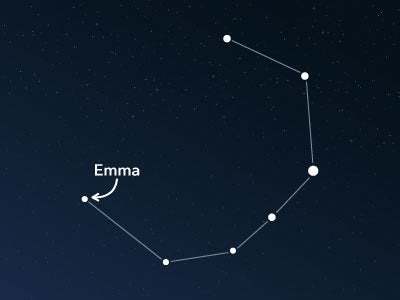The constellation Corona Borealis
Caratteristiche
- Nome latino
- Corona Borealis
- Emisfero
- Emisfero settentrionale
- Visibilità
- March - July
- Area
- 179 deg²
- Stella più luminosa
- Alphecca (HIP number 76267)
- Specialità
- Galaxy clusters

The Corona Borealis, Latin for Northern Crown, is one of the 48 classical constellations described by the Roman-Greek astronomer Claudius Ptolemy in ancient times. It is a relatively small constellation with a distinctive shape. The counterpart to the Corona Borealis is the Corona Australis.
Hemisphere, visibility, and area
The constellation is located in the northern celestial sky and can be observed from many places. It can be seen from all regions of the northern hemisphere and appears up to the 50th latitude south of the equator. It can thus be seen far south into Patagonia. It is not visible only in Antarctica but as well as for the surrounding islands and the ocean.
The best time period to observe the Corona Borealis in the night sky is from March to July. Especially in the northern spring months of March to May, the approximately 179 square degree constellation can be well observed. Compared to all other 88 constellations, the Corona Borealis ranks 73rd in size.
In star maps, the constellation stands out with its striking shape. It is visualized with a series of stars arranged in a semicircle, representing the Crown.
The brightest star is Alphecca (Latin: α Coronae Borealis, Alpha Coronae Borealis). It is also known by the Latin name Gemma, which means "jewel" in English. It is a double-star system located about 76.5 light-years away. The apparent magnitude of the binary star is approximately 2.2.
The Corona Borealis is nestled between the two well-known constellations, Hercules and Boötes, in the night sky. Additionally, the Serpens (Caput) borders to the south.
Specialties in the constellation
There are no deep-sky objects visible to the naked eye located within the area of the Corona Borealis.
However, the large galaxy cluster Abell 2065 lies in the constellation’s boundaries. It contains around 400 galaxies that are located about one billion light-years away. Due to this distance, they are not particularly bright and can only be seen in long-exposure astronomical photographs or large telescopes.
Abell 2065 belongs to the Corona Borealis Supercluster, which contains a total of 7 galaxy clusters. Compared to the other galaxy clusters, Abell 2065 is the richest cluster and thus forms the gravitational core of the supercluster.
Mythology and history
The shape of the constellation inspired many cultures to interpret its representation. The Greeks early on recognized a crown. The Arabs saw a beggar's bowl, the Celts a castle, and the Chinese a money chain. The Australians identify the constellation with a boomerang.
The origin story of the constellation in Greek mythology revolves around the hero Theseus and Ariadne, the daughter of King Minos of Crete. Theseus was trapped in the labyrinth of the monster Minotaur and was to be sacrificed to him.
However, Ariadne gave Theseus a thread that freed him from the maze. They then fled together from Crete to the island of Naxos. Theseus left Ariadne on Naxos, and she was taken as a wife by the god Dionysus. At their wedding, he threw her crown adorned with precious stones into the sky, where it was immortalized as a constellation.
PubblicatoLeggi altri articoli interessanti

An overview of all 88 constellations
Learn more about all 88 constellations and read interesting information about the mythology, visibility, and features.

App Planetario
Discover the night sky with our planetarium app!
Available for iOS and Android.

Dai un nome a una stella nella costellazione Northern Crown
Name a star in a constellation and create something that lasts for eternity.